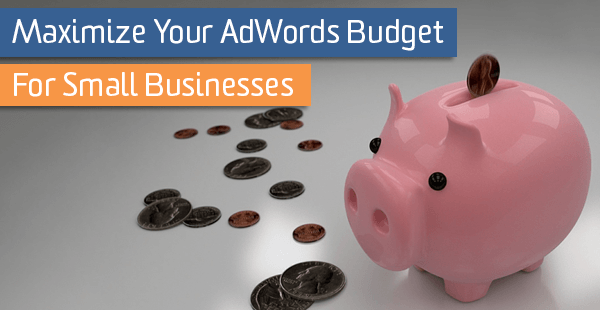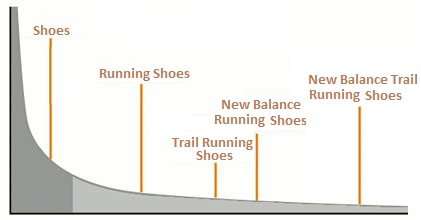Maximize Your AdWords Budget For Small Businesses

Most small businesses have only have a small chunk of change for their advertising, which means you cannot afford to be wasting your money in ineffective areas. This post will help anyone with a small advertising spend in AdWords to narrow their target audience in Google search results. Following the three sections will make sure your ad is there at the right time and place for the right customers.
Setter-and-forgetters can skip this post. This is for those that want to take actionable steps to up their advertising game and maximize their precious, hard-earned moola.
Danger Zone: Use These at Your Own Risk
There are certain features you want to avoid while running Google AdWords, unless you want Google making the decisions for you. Many of the suggestions in this article can only be implemented when not using these settings. If you want to take that next step with your AdWords account, its best to leave these alone.

AdWords Express Account
Google offers AdWords Express for quick account set ups for those who do not have much time on their hands. You give Google three lines of information about your business and an ad, and they handle the rest. Sounds appealing, no?
This is the ultimate no-no if you want to have control over your marketing strategy. Although you are getting up and running fast, you have no say in your keywords you will be advertising on and cannot use cool functions, like ad scheduling and location targeting.
If you already have an AdWords Express account and would like to upgrade, you will need to get in contact with Google. Here is a link to get you started.
Search Network with Display Select Campaign Type
This campaign type works similarly to “Search Network only”, but takes your search ad copy and places them on web pages relevant to your keywords across the internet. There are two issues with this campaign type:
- You have no way to limit your budget between Display and Search ads, because budget is controlled at the campaign level. Display ads typically use up their budget much faster than Search ads and bring in less relevant traffic.
- Reporting and analyzing the data is more difficult with the overlap. This is key in making smart marketing decisions.
To keep it straight, use the “Search Network only” and “Display Network only” campaign types, instead of using “Search Network with Display Select”.
Standard Campaign Subtype
After separating your Display and Search campaigns, you will want to be sure that you are not using the “Standard” campaign subtype, and instead are using the “All Features” subtype. As the subtype name suggests, “All Features” allows you to use all the tools that AdWords makes available. “Standard” is meant for easier set up, but does not give you the ability to maximize your accounts potential.
Narrow Down Your Targeting
Google AdWords is an endless wall of advertising space. You have so many places that you could hang your ad on the wall, but every person who inquires about it costs you money, even if what they were looking for is in a different city or they are using a homograph of your service to describe what they want.
Luckily there are ways to curtail these inquiries and make sure you only reach serious buyers.

Only the most serious of buyers
Ad Schedule
Within each campaign setting, you can create bid adjustments for different times of the day and days of the week. If your business only runs during specific times, then you can use this feature to run your ads only during these times. You do this by decreasing your bid adjustment by 100% during the times you do not want to show your ad. This could be helpful if you are a B2B company that only wants to run your ads during regular business hours, when you have people near the phone, ready to pick up for interested customers.
Alternatively, this feature can also be beneficial during busier times of the day when you want your ads to be more aggressive. You can bid higher during the times and days of the week that your business is busiest. Just be careful, if you have any other bid adjustments stacked on top of each other, these will be multiplied together to a maximum of 900%.
Location Targeting
Many small businesses do not operate worldwide, so it does not always make sense to target someone on the other side of the globe. Similar to the ad schedule, you can select specific locations to target in the campaign settings.
Here you can target cities, regions, states, countries and more. You can even target a specific radius around a location. So if you were running a local ice cream store, you could limit your ad to only those within five miles of your store.
Device Targeting
Every good advertiser has a strong call-to-action in their ad. Whether it is to fill out a form, to make a purchase, or to sign up for a newsletter, there should be an action you want a user to make once they have clicked your ad.
The ability to complete this action can be impeded by the device that the users are using. For example, filling out a long application will likely not be completed on a mobile device or making a phone call for a restaurant reservation is more likely to happen on cell phone.
We can use bid adjustments at either the campaign or ad group level to prefer either computers, mobile phones, or tablets. These bid adjustments can also be used to exclude a device type entirely, just like the ad scheduling bid adjustments.
If you are unsure which device works best for your conversions, let all the device types run and use the Segment feature to see how your campaigns/ad groups/keywords perform for each of the device types.
Long-Tail Keywords
Choosing the right keywords can make or break your AdWords account. For Search campaigns, they are the tool of communication with Google to place your ad on the expansive advertising wall. To use your AdWords budget effectively, it is best to give Google keywords that have high intent and are directly relevant to your business.
Keywords with high intent tend to be long-tail keywords. These are keywords that include additional detail about a product or service. Here is an example, where the keywords on the left of the graph are generic, high volume keywords and the ones on the right are long-tail keywords:

Long-tail keywords not only tend to convert at a higher rate, they also have the tendency to cost less per click, because they have less competition. This is how you are able to get more bang for your buck with long-tail keywords compared to the high volume short-tail keywords. Ubersuggest.io and Answer the Public are great tools to help you find long-tail keywords.
Keyword Match Types
Another way to keep out the lower performing traffic is by using more specific keyword match types. Keyword match types tell Google how broad they can extrapolate a keyword. For example, the broad match keyword coffee mug might match into search queries about coffee beans or the average consumption of cups of coffee. Broad match keywords can be a great way to find new keywords for the account, but unless you have a large budget, you will feel better knowing you did not spend money on a click searching on national statistics on coffee consumption.
With a limited budget it is best to stick to exact, phrase, and modified broad match types. If you stick to these 3 match types you are ensuring the keywords that you are using have to be contained somewhere within the user’s search queries.
Don’t forget to add negative keywords whenever you find search terms that you don’t want to spend your budget on!
Always Strive for Continuous Improvement
Now for the neverending story of AdWords: testing. The best way to improve your account is to always test ad copy, landing pages, bidding strategies, and more and then compare the results to past performance. The more you learn, the better, even if you find out the test did not work. At least you learned something.

Don’t let your account get stuck in a performance rut
There are many important metrics that you will want to try and improve upon when trying to maximize your budget’s effectiveness, like conversion rate, clickthrough rate, and cost-per-click, but one you might not have been aware of is your keyword’s Quality Score. This metric determines how much you are going to have to bid for specific locations on the page. An advertiser with a Quality Score of 10 would have to bid 1/10th the amount as an advertiser with a Quality Score of 1 for the same ad position. Every point that you can boost your Quality Score will make you that much more competitive and save you some extra dough for more clicks.
You can increase your Quality Score by improving your ad copy relevance to the keywords you are targeting, increasing your expected clickthrough-rate of an ad, and improving the landing page experience. Simply put, you can increase it by experimenting with different ad copy and by testing new landing pages.
Whatever you are testing within the account, always try to keep all variables within the experiment constant besides the variable you are testing. So for example, if you are testing ad copy, try to only test either a Headline or the Description Line, never both at the same time. By doing this you can attribute the differences in the performance to a specific change and take action from what you have learned from it.
If you are spending money with AdWords, you might as well take full advantage of its capabilities. Setting up the bare minimum is better than nothing, but you are not going to make your account more effective by letting the account sit there unchanged month over month. Hopefully, you can take a few of the suggestions from here, apply them, and take your new, hard-earned conversions and learned customer behavior to the bank!


